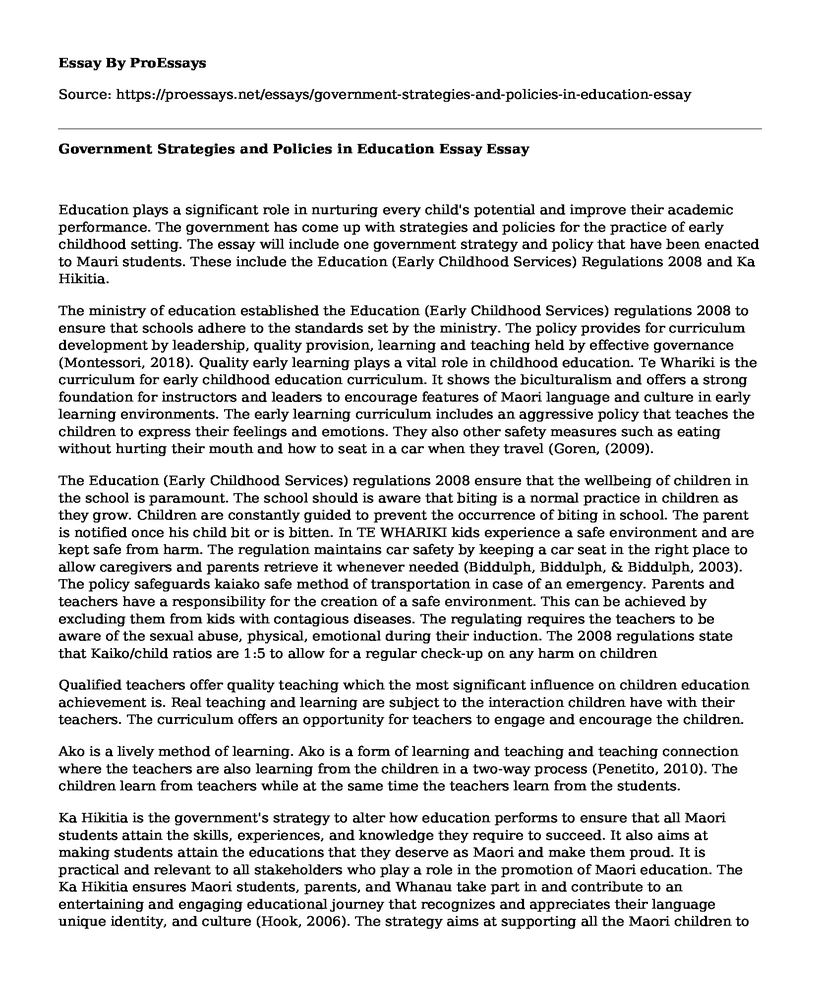Education plays a significant role in nurturing every child's potential and improve their academic performance. The government has come up with strategies and policies for the practice of early childhood setting. The essay will include one government strategy and policy that have been enacted to Mauri students. These include the Education (Early Childhood Services) Regulations 2008 and Ka Hikitia.
The ministry of education established the Education (Early Childhood Services) regulations 2008 to ensure that schools adhere to the standards set by the ministry. The policy provides for curriculum development by leadership, quality provision, learning and teaching held by effective governance (Montessori, 2018). Quality early learning plays a vital role in childhood education. Te Whariki is the curriculum for early childhood education curriculum. It shows the biculturalism and offers a strong foundation for instructors and leaders to encourage features of Maori language and culture in early learning environments. The early learning curriculum includes an aggressive policy that teaches the children to express their feelings and emotions. They also other safety measures such as eating without hurting their mouth and how to seat in a car when they travel (Goren, (2009).
The Education (Early Childhood Services) regulations 2008 ensure that the wellbeing of children in the school is paramount. The school should is aware that biting is a normal practice in children as they grow. Children are constantly guided to prevent the occurrence of biting in school. The parent is notified once his child bit or is bitten. In TE WHARIKI kids experience a safe environment and are kept safe from harm. The regulation maintains car safety by keeping a car seat in the right place to allow caregivers and parents retrieve it whenever needed (Biddulph, Biddulph, & Biddulph, 2003). The policy safeguards kaiako safe method of transportation in case of an emergency. Parents and teachers have a responsibility for the creation of a safe environment. This can be achieved by excluding them from kids with contagious diseases. The regulating requires the teachers to be aware of the sexual abuse, physical, emotional during their induction. The 2008 regulations state that Kaiko/child ratios are 1:5 to allow for a regular check-up on any harm on children
Qualified teachers offer quality teaching which the most significant influence on children education achievement is. Real teaching and learning are subject to the interaction children have with their teachers. The curriculum offers an opportunity for teachers to engage and encourage the children.
Ako is a lively method of learning. Ako is a form of learning and teaching and teaching connection where the teachers are also learning from the children in a two-way process (Penetito, 2010). The children learn from teachers while at the same time the teachers learn from the students.
Ka Hikitia is the government's strategy to alter how education performs to ensure that all Maori students attain the skills, experiences, and knowledge they require to succeed. It also aims at making students attain the educations that they deserve as Maori and make them proud. It is practical and relevant to all stakeholders who play a role in the promotion of Maori education. The Ka Hikitia ensures Maori students, parents, and Whanau take part in and contribute to an entertaining and engaging educational journey that recognizes and appreciates their language unique identity, and culture (Hook, 2006). The strategy aims at supporting all the Maori children to achieve qualifications necessary in New Zealand, the ao Maori and the rest of the world.
References
Montessori, B. B. PARENTS HANDBOOK 2017-2018.
Penetito, W. (2010). What's Maori about Maori education?: The struggle for a meaningful context. Victoria University Press.Goren, P. D. (2009). How Policy Travels: Making Sense of Ka Hikitia-Managing for Success: the Maori Education Strategy 2008-2012. Wellington, New Zealand: Fulbright New Zealand.
Biddulph, F., Biddulph, J., & Biddulph, C. (2003). The complexity of community and family influences on children's achievement in New Zealand: Best evidence synthesis. Wellington: Ministry of Education.
Hook, G. R. (2006). A future for Maori education Part I: the dissociation of culture and education. Mai Review, 1(2), 1-14.
Cite this page
Government Strategies and Policies in Education Essay. (2022, Jun 06). Retrieved from https://proessays.net/essays/government-strategies-and-policies-in-education-essay
If you are the original author of this essay and no longer wish to have it published on the ProEssays website, please click below to request its removal:
- Frank Serpico's Frustration in Attempting to Report Corruption: Research Paper
- The Benefits and Challenges of Studying Abroad: Essay Sample
- Digital Learners of 21st Century: A Guide for Educators - Essay Sample
- NASA Investment: Essential for America's Superpower Status - Essay Sample
- Legislative Changes & Gideon J. Tucker: Navigating Legal Battles With Diligent Watchfulness - Essay Sample
- Paper Example on OpenStax: Free Textbooks Provide Benefits to Learners
- Paper Example on Balancing Act: The Pros and Cons of Students' Internet Use







